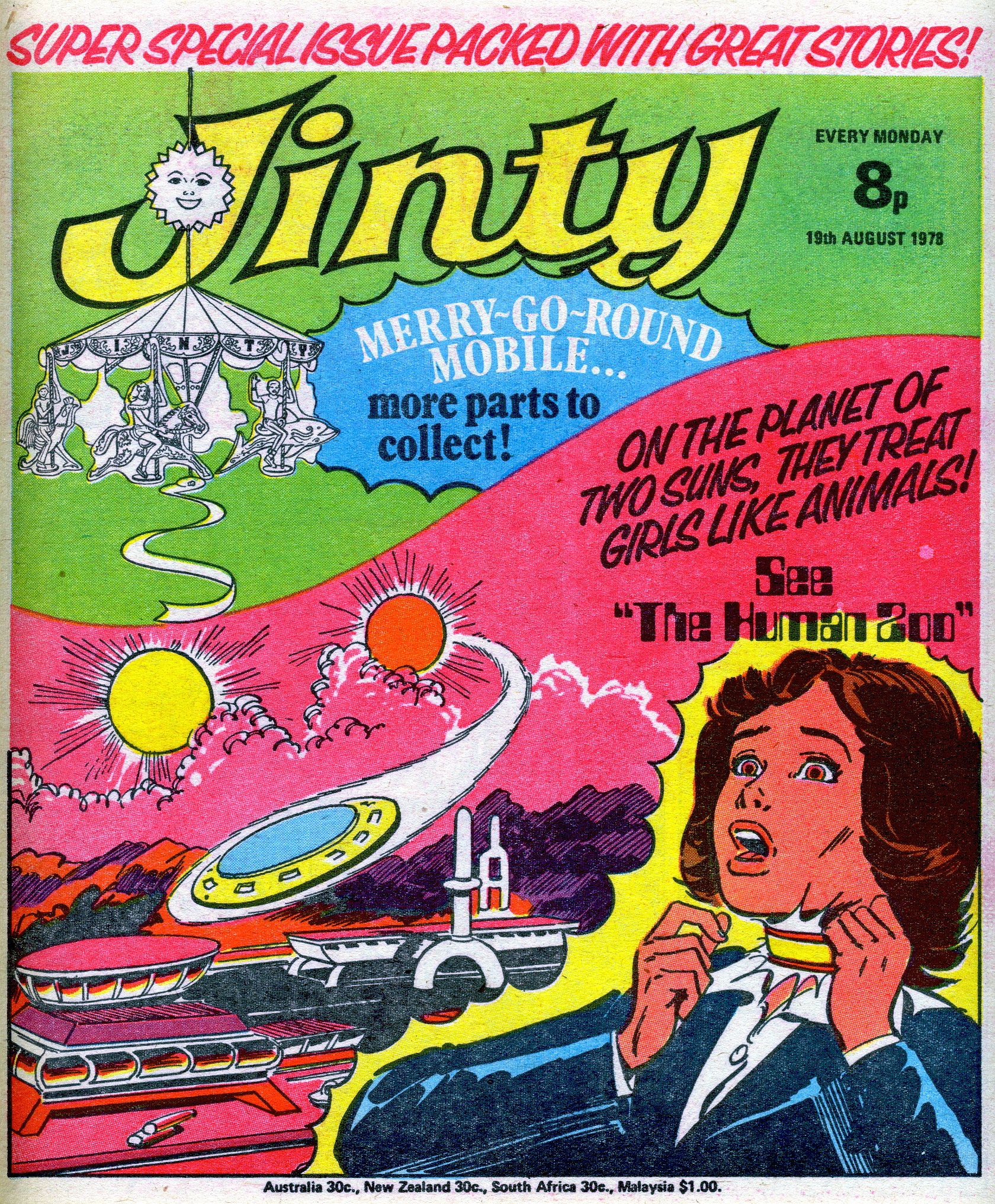- Jinty (comics)
Supercbbox| title = Jinty
comic_color =background:#c0c0c0

caption = Cover from issue of "Jinty", 19 August 1978. Art by Guy Peeters.
schedule = Weekly
format =
publisher = IPC Magazines, Fleetway Publications
date = 1974 - 1981
issues = Approx 380
main_char_team =
past_current_color=background:#ff9275
writers =
artists =
pencillers =
inkers =
colorists =
creative_team_month =
creative_team_year =
creators =Jinty was a weekly British comic for
girl s published byFleetway inLondon from 1974 to 1981, at which point it merged with Tammy. It had previously merged with Penny [http://www.comicsuk.co.uk/Gallery/NormalDisplayMain.asp?ImageLocation=../images/covers500/Jinty_70.jpg&series=&under] ] in a similar fashion, illustrating the 'hatch-match-dispatch' process practiced by editorial staff in the London comics publisher.
As well as the weekly comic,
Christmas annuals were also published. While there were similarities with itsFleetway stablemates Tammy and Misty, each comic had its own focus, with "Jinty" concentrating on science fiction or otherwise fantastical stories.Publishing format
As with other girls' comics of the time, "Jinty" consisted of a collection of many small strips. A typical weekly issue would publish six or seven serial stories, each consisting of around three or four pages of story ending in a cliff-hanger. The first page of the story included a text-box briefly summarizing the story so far, while the final page included a teaser line of text for the next week's episode.
In addition to the serial stories, a small number of standalone strips were normally published. Usually these were humorous and featured the same lead character week after week. "Alley Cat", "Penny Crayon", and others were a single page long, while "Sue's Fantastic Fun-Bag!" ran to two pages each week. A lead strip in the early days, often taking the cover slot, was "The Jinx From St Jonah's", which normally featured a standalone story but occasionally continued it in a subsequent week. An exception to the humour format was the storyteller format, in which the same narrator would each week tell a different "spooky" or "eerie" story. In "Jinty", that narrator was the character "Gypsy Rose".
Other features includes a letters page, horoscopes, occasional text stories, feature articles on pop or media stars, and various articles on creative things to make and do.
"Jinty" was printed on newsprint using at most two colours on internal pages and a four-colour process on the external cover pages.
Themes and key stories
While a large number of the stories published in "Jinty" were realistically based in everyday life (such as 'Pam of Pond Hill', an episodic tale of a young girl at a
Comprehensive school ), it differentiated itself from other comics in printing more stories with a science fictional or fantastical focus.
* "Fran of the Floods", 1976 (artist Phil Gascoigne): the earth gets hotter and Britain is flooded. Fran must journey over the flooded countryside to find her family.
* "Jassy's Wand of Power", 1976 (artist Keith Robson): this time, climate change has led to a drought. Jassy has a quasi-supernatural power of dowsing for water.
* "The Robot Who Cried", 1977 (artist Comos): robot KT-5 is built in the shape of a human girl and escapes to find her freedom and to discover human emotions.
* "Battle of the Wills", 1977 (artist Trini): a girl discovers a scientist with a duplicating machine that enables her to continue with her gymnastics while her double is forced to do ballet
* "Land of No Tears", 1977 - 78 (artistGuy Peeters , writerPat Mills ): a girl with a limp travels to a dystopian future in which she is a second-class citizen, but nevertheless she encourages her peers to fight against this
* "The Human Zoo", 1978 - 79 (artistGuy Peeters , writerPat Mills ): twin girls and their classmates are kidnapped by telepathic aliens to whom humans are mere animals
* "Worlds Apart", 1981 (artistGuy Peeters , writerPat Mills ): six schoolgirls find themselves in a series of strange worlds governed by their main characteristics: greed, love of sport, vanity, delinquency, intellectualism, and fear.Some of the published stories show a strong environmental concern.
* "The Goose Girl", 1977 (artist Keith Robson): the protagonist wants to become a nature artist and environmentalist rather than a fashion designer as her mother wishes her to
* "The Green People", June 1975 (artist Phil Gascoigne): the protagonist fights against plans to build a new road, which will endanger her newly-acquired telepathic friends from a forgotten green and subterranean race.Other stories covered ground seen in many traditional girls' comics.
* Humour stories included "Dora Dogsbody" from 1974 (artistJosé Casanovas ) and "Fran'll Fix It!" 1977 with a second series in 1978 (artistJim Baikie )
* Historical stories included "Merry at Misery House" (artist unknown) and "Bound for Botany Bay" (artist unknown)Creators featured in "Jinty"
Problems of attribution
Artists and writers were not credited in "Jinty". Artists can be identified by their work in other comics, whether girls comics such as Tammy (which moved to a system of crediting creators in the early 1980s) or in boys' comics such as 2000AD which had such a policy from earlier on. In other cases, it is possible to identify the artists from signatures on the comics page.
Identification of writers in "Jinty" is currently dependent on information given by the writers themselves.
Artists
Artists featured in the pages of "Jinty" included
Phil Gascoigne (who was in each issue from the very first until the last), artist for "No Cheers for Cherry" and "Badgered Belinda",Jim Baikie , artist for "Left-Out Linda","Face The Music, Flo!", "Ping-Pong Paula", "Miss No-Name", "Willa on Wheels", "Rose Among the Thornes", "Spell of the Spinning Wheel", "Two Mothers for Maggie", "Wild Rose" and "The Forbidden Garden",José Casanovas and many other Spanish artists, and less well-known British comics artists such asAudrey Fawley [http://bearalley.blogspot.com/2006/11/audrey-fawley.html Audrey Fawley interviewed by Steve Holland] ] ,Philip Townsend and Keith Robson.Writers
Writers featured included
Pat Mills .Notes
Wikimedia Foundation. 2010.
